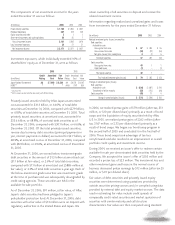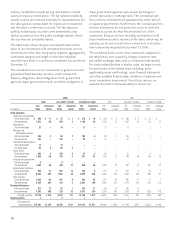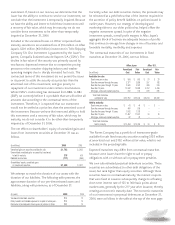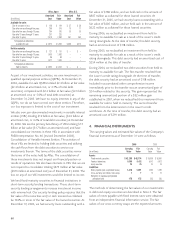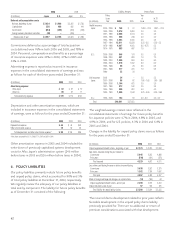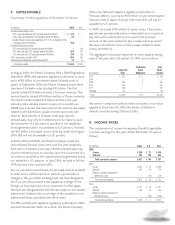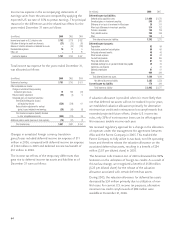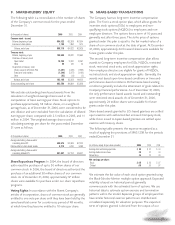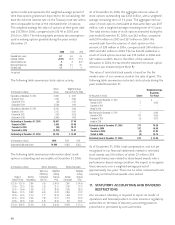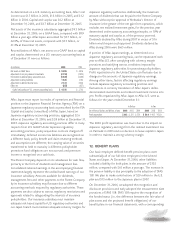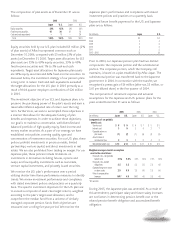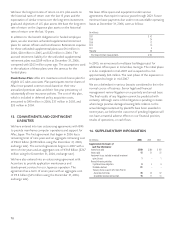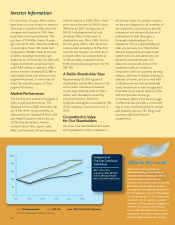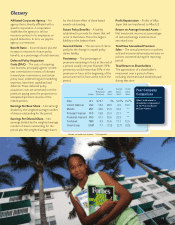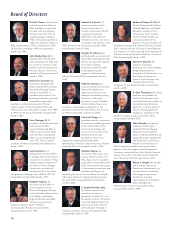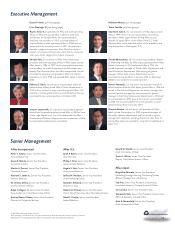Aflac 2006 Annual Report Download - page 71
Download and view the complete annual report
Please find page 71 of the 2006 Aflac annual report below. You can navigate through the pages in the report by either clicking on the pages listed below, or by using the keyword search tool below to find specific information within the annual report.
67
As determined on a U.S. statutory accounting basis, Aflac’s net
income was $1.7 billion in 2006, $1.3 billion in 2005, and $1.2
billion in 2004. Capital and surplus was $4.2 billion at
December 31, 2006, and $3.7 billion at December 31, 2005.
Net assets of the insurance subsidiaries aggregated $9.3 billion
at December 31, 2006, on a GAAP basis, compared with $8.9
billion a year ago. Aflac Japan accounted for $5.7 billion, or
62.0%, of these net assets, compared with $5.5 billion, or
61.4% at December 31, 2005.
Reconciliations of Aflac’s net assets on a GAAP basis to capital
and surplus determined on a U.S. statutory accounting basis as
of December 31 were as follows:
(In millions) 2006 2005
Net assets on GAAP basis $ 9,266 $ 8,916
Adjustment of carrying values of investments (2,153) (2,825)
Elimination of deferred policy acquisition costs (5,922) (5,499)
Adjustment to policy liabilities 1,526 1,194
Adjustment to deferred income taxes 2,124 2,546
Other, net (655) (627)
Capital and surplus on U.S. statutory accounting basis $ 4,186 $ 3,705
Aflac Japan must report its results of operations and financial
position to the Japanese Financial Services Agency (FSA) on a
Japanese regulatory accounting basis as prescribed by the FSA.
Capital and surplus (unaudited) of Aflac Japan, based on
Japanese regulatory accounting practices, aggregated $2.6
billion at December 31, 2006, and $2.8 billion at December 31,
2005. Japanese regulatory accounting practices differ in many
respects from U.S. GAAP. Under Japanese regulatory
accounting practices, policy acquisition costs are charged off
immediately; deferred income tax liabilities are recognized on
a different basis; policy benefit and claim reserving methods
and assumptions are different; the carrying value of securities
transferred to held to maturity is different; policyholder
protection fund obligations are not accrued; and premium
income is recognized on a cash basis.
The Parent Company depends on its subsidiaries for cash flow,
primarily in the form of dividends and management fees.
Consolidated retained earnings in the accompanying financial
statements largely represent the undistributed earnings of our
insurance subsidiary. Amounts available for dividends,
management fees and other payments to the Parent Company
by its insurance subsidiary may fluctuate due to different
accounting methods required by regulatory authorities. These
payments are also subject to various regulatory restrictions and
approvals related to safeguarding the interests of insurance
policyholders. Our insurance subsidiary must maintain
adequate risk-based capital for U.S. regulatory authorities and
our Japan branch must maintain adequate solvency margins for
Japanese regulatory authorities. Additionally, the maximum
amount of dividends that can be paid to the Parent Company
by Aflac without prior approval of Nebraska’s director of
insurance is the greater of the net gain from operations, which
excludes net realized investment gains, for the previous year
determined under statutory accounting principles, or 10% of
statutory capital and surplus as of the previous year-end.
Dividends declared by Aflac during 2007 in excess of $1.6
billion would require such approval. Dividends declared by
Aflac during 2006 were $665 million.
A portion of Aflac Japan earnings, as determined on a
Japanese regulatory accounting basis, can be repatriated each
year to Aflac U.S. after complying with solvency margin
provisions and satisfying various conditions imposed by
Japanese regulatory authorities for protecting policyholders.
Profit repatriations to the United States can fluctuate due to
changes in the amounts of Japanese regulatory earnings.
Among other items, factors affecting regulatory earnings
include Japanese regulatory accounting practices and
fluctuations in currency translation of Aflac Japan’s dollar-
denominated investments and related investment income into
yen. Profits repatriated by Aflac Japan to Aflac U.S. were as
follows for the years ended December 31:
In Dollars In Yen
(In millions of dollars and billions of yen) 2006 2005 2004 2006 2005 2004
Profit repatriation $ 442 $ 374 $ 220 ¥ 50.0 ¥ 41.2 ¥ 23.9
The 2004 profit repatriation was lower due to the impact on
Japanese regulatory earnings from the realized investment loss
on Parmalat in 2003 and our decision to leave capital in Japan
in order to maintain a strong solvency margin.
12. BENEFIT PLANS
Our basic employee defined-benefit pension plans cover
substantially all of our full-time employees in the United
States and Japan. At December 31, 2006, other liabilities
included a liability for both plans in the amount of $102
million, compared with $65 million a year ago. The increase in
the pension liability is due principally to the adoption of SFAS
158. We plan to make contributions of $20 million to the U.S.
plan and $13 million to the Japanese plan in 2007.
On December 31, 2006, we adopted the recognition and
disclosure provisions and early adopted the measurement date
provisions of SFAS 158. SFAS 158 requires the recognition of
the funded status (i.e., the difference between the fair value of
plan assets and the projected benefit obligations) of our
benefit plans in our financial statements, with a corresponding


